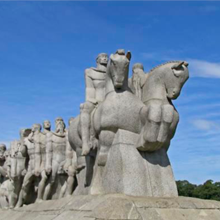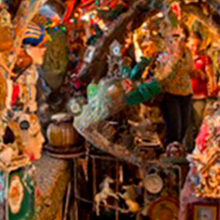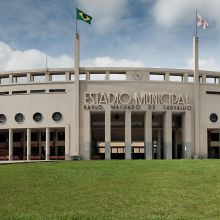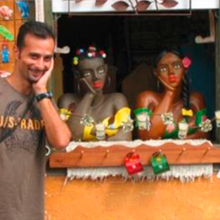É necessário finalizar a compra atual para seguir com a compra da passagem aérea.
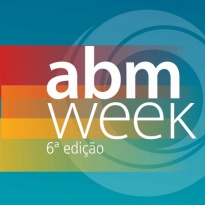
ABM Week 6th Edition
06/07 to 06/09/2022
Pro Magno Centro de Eventos
Tours
-
The Best of São Paulo
A tour along São Paulo's most representative sights. It begins with the presentation of the Ibirapuera Park, the main green area of the city, where we showcase the historical importance of the Obelisk of São Paulo and Monumento às Bandeiras (Monument to the Flags), and several art-woks made by Oscar Niemeyer, such as the Museum of Contemporary Art (MAC) and the Oca. The route follows through the chic streets of the Jardins neighborhood, highlighting the architectural...R$ 127.00 per passenger -
'Tour Contemporâneo
In this tour, we suggest a visit to some places that features a variety of Brazil's most remarkable contemporary art styles, broadly found on the streets, galleries, museums and even at the slum areas of São Paulo. The tour begins with a visit to one of the best-known art galleries that hosts exclusive works made by renowned national artists. After that, we will see some murals shown in an open-air area of the Batman Alley and Apprentice Alley, unique urban passages lined with...R$ 127.00 per passenger -
'Football Tour
São Paulo gathers many fans, stadiums and also some of the major soccer teams of Brazil. During this tour, passengers will do a guided visit to the Football (Soccer) Museum. Founded in September 2008, it hosts a rich collection of relics, curiosities and updates of the sport, so as temporary exhibitions, featured with great creativity and interactivity. The tour also includes a visit to the famous Morumbi Stadium home of the Sao Paulo Football Club), where visitors will have the...R$ 152.00 per passenger -
'Embú das Artes
Known as the "City of Arts", the village originally appeared between 1555 and 1559, Nowadays it is internationally known as a place of gathering for painters, sculptors and artisans to exhibit their work in one of the 38 galleries, antique shops or in the famous Embu das Artes Fair (only available during weekends). The village also offers a rich food court and a space for shows of ornamental plants and flowers. While walking through winding alleys of colonial architecture, visitors learn a...R$ 149.00 per passenger -
'Embú das Artes
Known as the "City of Arts", the village originally appeared between 1555 and 1559, Nowadays it is internationally known as a place of gathering for painters, sculptors and artisans to exhibit their work in one of the 38 galleries, antique shops or in the famous Embu das Artes Fair (only available during weekends). The village also offers a rich food court and a space for shows of ornamental plants and flowers. While walking through winding alleys of colonial architecture, visitors learn a...R$ 149.00 per passenger -
'Embú das Artes
Known as the "City of Arts", the village originally appeared between 1555 and 1559, Nowadays it is internationally known as a place of gathering for painters, sculptors and artisans to exhibit their work in one of the 38 galleries, antique shops or in the famous Embu das Artes Fair (only available during weekends). The village also offers a rich food court and a space for shows of ornamental plants and flowers. While walking through winding alleys of colonial architecture, visitors learn a...R$ 149.00 per passenger -
'Embú das Artes
Known as the "City of Arts", the village originally appeared between 1555 and 1559, Nowadays it is internationally known as a place of gathering for painters, sculptors and artisans to exhibit their work in one of the 38 galleries, antique shops or in the famous Embu das Artes Fair (only available during weekends). The village also offers a rich food court and a space for shows of ornamental plants and flowers. While walking through winding alleys of colonial architecture, visitors learn a...R$ 149.00 per passenger -
'Embú das Artes
Known as the "City of Arts", the village originally appeared between 1555 and 1559, Nowadays it is internationally known as a place of gathering for painters, sculptors and artisans to exhibit their work in one of the 38 galleries, antique shops or in the famous Embu das Artes Fair (only available during weekends). The village also offers a rich food court and a space for shows of ornamental plants and flowers. While walking through winding alleys of colonial architecture, visitors learn a...R$ 149.00 per passenger -
'Embú das Artes
Known as the "City of Arts", the village originally appeared between 1555 and 1559, Nowadays it is internationally known as a place of gathering for painters, sculptors and artisans to exhibit their work in one of the 38 galleries, antique shops or in the famous Embu das Artes Fair (only available during weekends). The village also offers a rich food court and a space for shows of ornamental plants and flowers. While walking through winding alleys of colonial architecture, visitors learn a...R$ 149.00 per passenger -
'Embú das Artes
Known as the "City of Arts", the village originally appeared between 1555 and 1559, Nowadays it is internationally known as a place of gathering for painters, sculptors and artisans to exhibit their work in one of the 38 galleries, antique shops or in the famous Embu das Artes Fair (only available during weekends). The village also offers a rich food court and a space for shows of ornamental plants and flowers. While walking through winding alleys of colonial architecture, visitors learn a...R$ 149.00 per passenger -
'Embú das Artes
Known as the "City of Arts", the village originally appeared between 1555 and 1559, Nowadays it is internationally known as a place of gathering for painters, sculptors and artisans to exhibit their work in one of the 38 galleries, antique shops or in the famous Embu das Artes Fair (only available during weekends). The village also offers a rich food court and a space for shows of ornamental plants and flowers. While walking through winding alleys of colonial architecture, visitors learn a...R$ 149.00 per passenger


